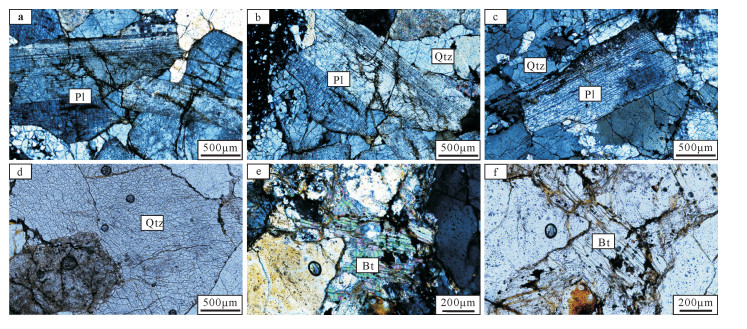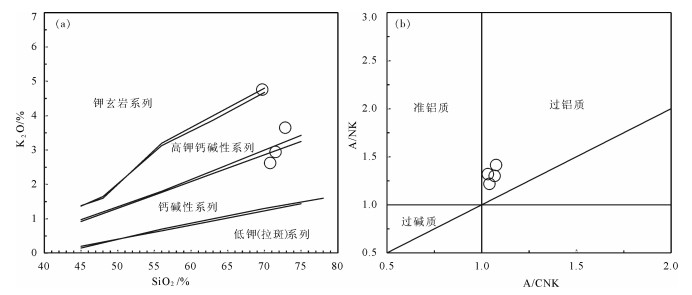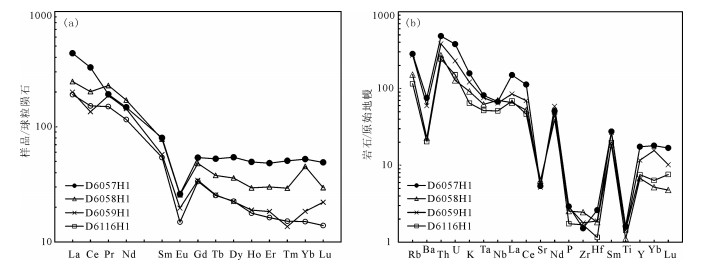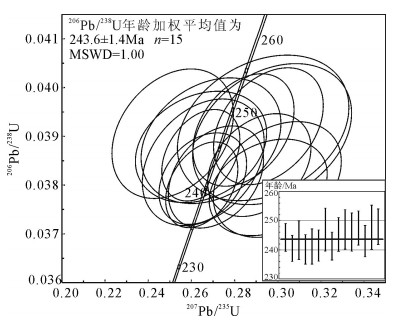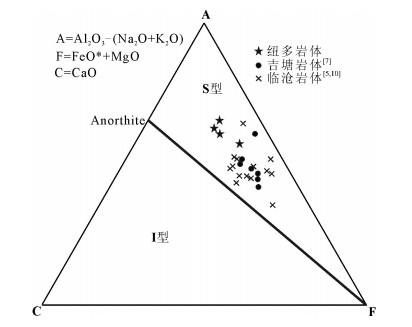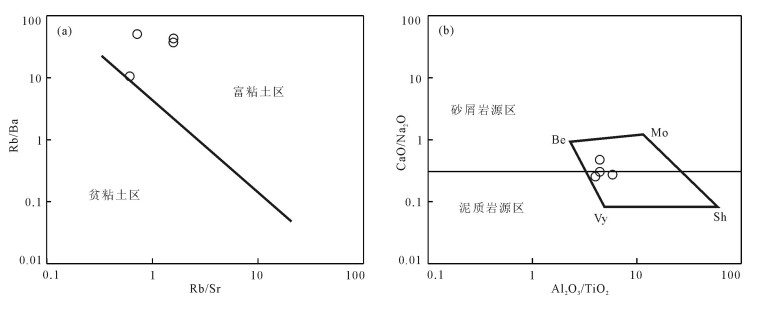Zircon U-Pb age and genesis of Niuduo biotite monzogranite in east Tibet
-
摘要:
通过对澜沧江北段卡贡地区出露的纽多黑云母二长花岗岩的岩石学、岩石地球化学及锆石U-Pb年龄的研究,分析了纽多黑云母二长花岗岩的地球化学和原岩特征。黑云母二长花岗岩中的锆石具有明显的振荡环带,较高的Th/U值(普遍大于0.4),属于典型的岩浆成因锆石,用LA-ICP-MS测得锆石206Pb/238U年龄为243.6±1.4Ma(MSWD=1.00,n=15),时代为中三叠世。岩石地球化学特征表明,该黑云母二长花岗岩具有较高的SiO2、Al2O3及高钾富碱的特征,A/CNK值为1.05~1.08,为过铝质高钾钙碱性系列;稀土元素配分模式显示,配分曲线为右倾型,具有明显的负Eu异常和弱负Ce异常,表现为Nb、Ta、P、Zr、Ti等高场强元素相对亏损,相对富集Rb、K、Th、U等大离子亲石元素。岩石地球化学特征表明,纽多黑云母二长花岗岩为S型花岗岩,形成于地壳加厚增温环境下的深熔作用。
-
关键词:
- 黑云母二长花岗岩 /
- 地球化学 /
- LA-ICP-MS锆石U-Pb测年 /
- 西藏纽多
Abstract:This paper presents geochronological and whole-rock geochemical data of Niuduo biotite monzogranite exposed in the north of Lancang granitoids to discuss the origin of the Niuduo biotite monzogranite and its geochemical characteristics. Zircons of biotite monzogranite show no euhedral crystals and have clear oscillatory zones as well as high Th/U ratios, suggesting magmatic origin. Zircon LA-ICP-MS dating of the biotite monzogranite yielded an age of 243.6±1.4Ma(MSWD=1.00, n=15), implying that the crystallization of the biotite monzogranite body took place in Middle Triassic. Petrological and geochemical studies show that it is characterized by high silicon and aluminum as well as abundant alkali, with A/CNK being 1.05~1.08, thus belonging to high-K calc-alkaline series. The whole-rock geochemical characteristics such as strongly fractionated REE pattern, apparently negative Eu anomalies and Ce anomalies, depleted Nb, Ta, P, Zr, Ti, and high Rb, K, Th, U suggest that it belongs to S-type granite. The authors hold that the melting took place at about 25km in the middle crust due to extension of the thickened crust after the closure of the paleo-Lancang Ocean. The results obtained by the authors support the hypothesis that the Lancang River tectonic zone represents a remnant Paleo-Tethyan main ocean preserved in the collision suture along a Gondwana-derived microcontinent.
-
Keywords:
- biotite monzogranite /
- geochemistry /
- LA-ICP-MS zircon U-Pb dating /
- Niuduo, Tibet
-
早中新世后,随着青藏高原隆升,亚洲季风增强,中国北方大部地区逐渐脱离原有的行星气候控制的干旱气候状况,向今天的暖温带季风气候系统转变[1-2],其生态系统也由原来的草原及荒漠草原为主的植被景观,转变为森林草原-落叶阔叶林为主[2]。亚洲季风区的典型暖温带植被系统不仅对全球周期性气候变化具有明显的指示意义,而且对过去数百万年时间的气候转型具有较好的响应,因此,是近年来研究过去全球变化的重点[3-4]。
晚新近纪以来,全球气候经历了几次重要的调整过程,其中最重要的就是中更新世时期全球气候格局的调整,又称中更新世转型[5-6]。其特征为从“高频低幅”的早更新世气候向中更新世以来“低频高幅”的气候波动,其气候变化周期由40ka的地轴倾斜度周期,转变为100ka 的轨道偏心率周期[7]。期间全球气候降温,陆地表面大部分地区因此变得更加寒冷干燥,冰期时,形成北美、欧洲的冰盖,非洲撒哈拉沙漠形成,亚洲内陆环境进一步干旱化,冬季季风强度增加等[7-9]。研究中更新世气候格局的重新调整,以及转型前后气候周期性对华北地区植被的影响,有利于了解不同区域植被对全球气候环境变化的响应特征,为研究重大气候转型中的生态环境效应提供重要对比参照物[10]。
华北平原主要包括淮北平原、黄河平原和海河平原三大区块,位于中国北方地区的东部,属典型的季风区。华北平原北部海河下游地区的凹陷盆地中沉积了厚度大于5000m 的新生带地层[11],其中第四系厚280~410m,最厚约450m。目前,基于这些新生带地层,华北地区的古植被研究已有较多积累,如河北黄骅HB1、衡水HS1 及天津CQJ1 孔花粉谱[12-14],天津G2 孔[15]。但是由于地层中花粉鉴定数量偏少、地层年代学不完善,以及区域地貌、沉积环境等多元因素的影响,用高质量孢粉数据来探讨更新世以来华北地区植被转型与气候变化问题的研究并不多见。本次研究利用华北地区东部天津滨海新区沉积凹陷中G3 钻孔的岩心材料,通过古地磁年代序列及较高质量的孢粉分析数据重建区域植被历史,并结合已有的植被重建资料,探讨第四纪以来华北地区的植被演变特征及气候变化过程。
1. 研究区自然地理概况
位于北纬32°~40°、东经114°~121°的华北平原是中国东部最主要的平原,平均海拔低于50m,由黄河、海河、淮河等带来的泥沙沉积而成。华北平原属暖温带季风气候,四季变化明显,冬季寒冷、少雪;春季干旱,夏季气温高、湿度大、降水集中;全年平均气温8~15℃。年平均降水量南部淮河区800~1000mm,黄河下游600~700mm,海河下游为500~600mm,年降水量分配不平衡,多年平均水面蒸发量为1625mm,降水随季节变化显著,冬、春季少,夏季集中[16]。
研究区自然植被主要由暖温带落叶阔叶林组成。在现代植被中,阔叶类的落叶栎(Quercus)植被组成受纬向的温度效应控制非常明显,在南部为麻栎(Quercus acutissima)、栓皮栎(Quercus variabilis),向北逐渐过渡为蒙古栎(Quercus mongolica)和辽东栎(Quercus liaotungensis)。针叶类以松属(Pinus)占主要地位,以赤松(Pinus densiflora)为主。另外常见温带的枫桦(Betula costata)、五加(Eleutherococcussenticosus)、核桃楸(Juglans mandshurica Max.)、椴属(Tilia)等。华北平原,尤其是海河平原,湖泊和沼泽广布,沼泽植被以芦苇(Phragmites)、香蒲(Ty⁃pha)、水葱(Scirpus)、苔草(Carex)等为主[17]。
全新世晚期以来,由于人类活动的持续加强,华北地区原生落叶阔叶林遭到大规模破坏,形成了今天普遍的灌丛及灌丛草原,其中灌木以荆条、酸枣为主,草丛以黄背草和白羊草为建群种。
2. 研究材料与研究方法
2.1 钻孔地理位置与磁性地层
天津G3 钻孔(孔口坐标:北纬117°25′59.5″、东经38°49′57.6″)位于华北平原东部天津滨海地区的海河南侧,构造上属于黄骅坳陷中的板桥凹陷。孔口高程2.65m,孔深905m(图 1)。岩心直径100mm,全孔取心率90.0%以上。因此,取心率和岩心状况满足磁性地层学及其他研究的要求。
G3 孔200m 以上磁性地层中共有6 个极性段,包括3 个正极性段(N1~N3)和3 个负极性段(R1~R3),正极性段分别为N1(0~85.0m)、N2(95.5~105.9m)和N3(177~191.8m),负极性段分别为R1(85.0~95.5m)、R2(105.9~177.0m)和R3(191.8~212.5m)。其中N1(0~85.0m)以正极性为主,并且包含明显的全新世海相层,对应布容极性时(Brunhes),故确定N1(0~85.0m)对应C1n(0~0.781Ma)。85.0~212.5m(R1~R3)以负极性为主,对应松山极性时(Matuyama),其中,N2(95.5~105.9m)对应C1r.1n(0.988~1.072Ma),为贾拉米罗(Jaramillo)正极性亚时,奥尔都微(Olduvai)正极性亚时持续事件长,且强度大,在渤海湾沿岸其他钻孔中亦有出现,因此推断N3(177~191.8m)对应C2n(1.778~1.945Ma),为Olduvai正极性亚时(图 2)。
2.2 花粉分析方法
天津滨海新区大港G3 钻孔花粉样品取样深度在0~905m 之间,取样间隔岩性为粘土、亚粘土、亚砂土和砂。每个样品重量为100g,经盐酸和氢氟酸处理、直径7μm 筛网筛选提取花粉化石。花粉鉴定统计在400 倍日本OLYMPUS 光学生物显微镜下进行,每个样品鉴定统计的花粉数是观察统计3 个玻片以上得到的。
在取得的165 个样品的大部分中发现了花粉化石,但仅在160m 以上发现连续而丰富的花粉,160m以下花粉数量稀少,绝大多数样品中不足50 粒。160m 以上共42 个样品中花粉相对丰富,其中绝大多数样品鉴定粒数高于100 粒,样品平均粒数为218粒。本文选择具有连续有效花粉数据的0~160m 地层(0~1.7Ma),用Tilia 软件对花粉图谱进行百分比图谱的绘制(图 3)。
2.3 研究结果
在42 个有效样品中,共鉴定了9167 粒花粉,分属48 个科属。其中针叶乔木花粉有铁杉属(Tsu⁃ga)、冷杉属(Abies)、云杉属(Picea)和松属(Pinus),落叶阔叶乔木花粉有桦属(Betula)、鹅耳枥属(Car⁃pinus)、桤木属(Alnus)、栗属(Castanea)、落叶栎属(Quercus)、椴属(Tilia)、胡桃属(Juglans)、榆属(Ul⁃mus)、糙叶树属(Aphananthe)、枫香属(Liquidanber)、山核桃属(Carya)、无患子科(Sapindaceae),灌木植物花粉有嚼床科(Acanthaceae)、胡秃子科(Elaeagna⁃ceae)、榛属(Corylus)、虎榛子属(Ostryopsis)、麻黄属(Ephedra)、忍冬科(Caprifoliaceae)、蔷薇科(Rosace⁃ae)。草本植物花粉有旱生的地榆属(Sangnisorba)、葎草属(Humulus)、藜科(Chenopodiaceae)、菊科(Compositea)、蒿属(Artemisia)、茜草科(Rubiace⁃ae)、唇形科(Labiatea)、豆科(Leguminosae)、茄科(Solanaceae)、蓼属(Polygonum)、十字花科(Crcife⁃rae)、石竹科(Caryophllaceae)、伞形花科(Umbella⁃les)等,水生植物有禾本科(Gramineae)、泽泻科(Alismataceae)、香蒲属(Typha)、莎草科(Cyperace⁃ae)、荇菜属(Nymphoides)。蕨类植物孢子有石松科(Lycopodiaceae)、水龙骨属(Polypodium)、凤尾蕨属(Pteridium)、卷柏属(Selaginella)、水蕨科(Parkeria⁃ceae)、单缝孢子(Monolites)和三缝孢子(Trilites)。
通过Canoco 4.5 软件对G3 孔中孢粉属种排序(图 4),发现所有属种可分为4 个类群:①以云杉、松为代表的温性针叶林;②以栎属、榛属、栗属、胡桃等为主的落叶阔叶林;③以蒿属、藜科、禾本科和桦属为主的草原及疏林草原;④以榆属、蔷薇科、胡颓子和铁杉为主的暖温性灌丛。根据属种的分布规律推断,图 4 中第一主轴(横轴)指示湿度,第二主轴(纵轴)指示温度。
如图 3 所示,根据孢粉聚类分析结果,将G3 孔中花粉百分比图谱分为4 个带。
(1)孢粉带Ⅰ:松属-云杉属-藜属-菊科-蕨类组合(1.6~1.2Ma)
乔木平均为58.6%,以松(12.7%~84.2%)和云杉(0~10.6%)为主,早期有少量铁杉,后过渡为云杉,此外还包含含量较低的栎属、榆属、椴属、桦属、胡桃属等常见暖温性阔叶乔木;草本中藜科最多,平均为8.1%,菊科含量平均4.3%,最高14.3%,蒿属含量少于菊科,平均仅2.8%。蕨类孢子在本带含量较丰富,以石松为主,另外还有水龙骨、凤尾蕨等蕨类。
本段组合指示暖温带针阔叶混交林的特点,其中松属为主要建群种,其花粉的突出代表性使松属在此时具有绝对优势。其中重要的变化在1.5Ma 前后,针叶林成分由铁杉向云杉转变的过程,显示一次降温事件,由此又可以划分出2 个阶段,即Ⅰ -1(1.6~1.5Ma)和Ⅰ -2(1.5~1.2Ma)。草本组合显示,1.5Ma 以前,菊科含量较高,而到后期,禾本科含量逐渐增加,菊科花粉基本消失,显示了区域草地环境由湿转干的过程。
(2)孢粉带Ⅱ:松属-栎属-藜-蒿组合(1.2~0.7Ma)
本段乔木花粉整体比例下降,松属比例由上段的平均51%下降至15%左右,云杉、铁杉等针叶树基本消失,但落叶栎属比例由带Ⅰ的1.2%,显著上升为13.0%,同时桦属花粉也显著增加,另有少量栗属、榆属、胡桃属等阔叶树。草本花粉组成也发生重要改变,藜科、蒿属比例大幅度增加,并伴随禾本科与香蒲属花粉的增加。蒿属平均值由原来的2.7%增加为20.7%。
本段孢粉组合指示暖温带落叶阔叶林的植被特征。草本花粉,尤其是蒿属的比例大幅度增加,显示华北地区在该阶段林地消退与草原发展,指示该时期气候干旱化。
(3)孢粉带Ⅲ:栎属-松属-藜-蒿-香蒲组合(0.7~0.3Ma)
本段乔木花粉比例最低,松属平均值由15%进一步下降,栎属略有下降,伴随较多的桦属与少量云杉属、铁杉属,并出现了零星的枫香属、山核桃属花粉。草本中藜科和蒿属依然占据主导地位,显示草原继续发展,而香蒲比例大幅度上升,显示周边地区湖泊湿地的扩展。本段孢粉组合指示疏林草原的植被景观,同时,湖泊湿地开始大规模发育。
(4)孢粉带Ⅳ:松属-栎属-藜-蒿-香蒲组合(0.3~0Ma)
本段针叶乔木花粉比例回升,松属增加至22.1%,云杉、铁杉花粉含量也有显著增加,而阔叶类乔木比例下降,栎属略微下降,枫香属、山核桃属消失,出现少量椴属、栗属、榆属、胡桃属等阔叶树。草本主要变化为藜科比例下降和香蒲比例升高。本段孢粉组合指示以暖温带落叶阔叶林为主的植被景观,湖泊湿地持续发育。
3. 讨论
3.1 演变趋势
中更新世气候转型期间,全球冰量整体增加了约15%,平均温度显著下降。对于其转型时间,大部分研究显示其大约开始于1.2Ma[6],另一些研究认为稍晚,在约1.05Ma,或是0.9Ma 前后,另外有人认为这种转型也可能是以一种渐进的方式进行的,始于1.2Ma,到约0.6Ma 才完成转型[18]。
G3 孔指示的中国华北平原地区中更新世植被转型期,对应上述的孢粉带Ⅱ,显示华北地区植被转型开始发生于1.2Ma,主要表现为林地减少,喜湿的针叶林比例下降,较为干旱的落叶阔叶林增加,同时藜科、蒿属、禾本科等草地面积显著增加。这种变化在1.2Ma 左右的某个时间点发生,大致相当于深海O 同位素36 阶段。
黄骅HB1、衡水HS1、天津CQJ2 孔、天津G2 孔的1.28~2.80Ma 为暖温带落叶阔叶林的景观,整体上较暖湿。1.28Ma以来,典型暖温带阔叶乔木花粉比例减小,华北平原草地扩张,而黄骅HB1 孔与衡水HS1 孔在中更新世前后也发生了类似事件[12-15]。
尽管由于孢粉数据分辨率的问题,所有这些钻孔的花粉百分比变化在时间上没有完好吻合,但是1.2Ma 前后,中更新世转型期推动华北平原地区植被整体向干旱类型发展是具有普遍性的。
此后,大约在0.7Ma 前后又发生一次重大转型,林地进一步退化,区域植被由原来的落叶阔叶林向疏林草原转变,对应深海O 同位素18 阶段。之后这种趋势一直延续到0.3Ma 左右才发生转变。黄骅HB1 孔中,0.8~0.7Ma 以后以蒿属和香蒲属为主,草本花粉出现,并分别达到12.5% 和10.9%,衡水HS1孔中以蒿和藜科为代表的草本花粉在0.78Ma 后也显著增长,显示华北平原0.7~0.8Ma 前后草地植被显著扩张[12-14]。此后,在约0.3Ma,即大约O 同位素8 阶段以后,华北地区植被中林地比例再度增加,可能与深海O 同位素11 阶段以后的7 阶段,5 阶段等几次典型的高温期有关。
3.2 周期性气候变化的区域植被响应
尽管由于样品分辨率的问题,周期性气候变化导致的区域植被变化未能完全被花粉谱记录,以致花粉谱更多地指示了区域植被在万年尺度的长期发展趋势。但是,不论是1.2Ma 之前的40ka 轨道倾斜度周期性,还是1.2Ma 之后的100ka 轨道偏心率周期,周期性气候变化对植被的影响,在花粉谱中确有一定表现。
例如在孢粉带Ⅰ中,以松为代表的乔木花粉比例的波动变化为10%~80%,可能对应该时期由地轴倾斜度40ka 周期变化导致的区域植被的变化。在带Ⅳ 也有类似的波动响应。由此可见,不论是1.2Ma 之前40ka 周期的“ 高频低幅”变化,还是1.2Ma 之后,100ka 周期的“低频高幅”变化,对华北地区的植被都有显著影响。
如图 3 所示,华北地区植被在1.6~1.2Ma 期间在40ka 气候周期“高频低幅”的变化中,主要表现为松属、常绿栎、铁杉属、胡桃属的交替变化,指示了区域暖温性与温性植被林地类型的交替变化。而1.2Ma 之后随着草原植被的扩张,100ka 周期的“低频高幅”变化造成的华北地区区域植被的响应更多地表现为草原与森林的交替发展。
4. 结论
华北平原东北部天津G3 孔孢粉数据及周边地区已有花粉研究表明,华北平原地区1.6Ma 以来的植被演化主要可以分为4 个阶段:①1.6~1.2Ma 密闭度较高的暖温带针阔叶混交林;②1.2~0.7Ma 开阔的暖温带落叶阔叶林;③0.7~0.3Ma,阔叶疏林草原;④0.3Ma 至今,暖温带落叶阔叶林。
中国华北平原地区中更新世植被转型期对应于孢粉带Ⅱ,显示该转型始于1.2Ma,大致对应深海O 同位素36 阶段。主要特征为林地减少、喜湿的针叶林比例下降,较为干旱的落叶阔叶林增加,同时,藜科、蒿属、禾本科等草地面积显著增加。
大约在0.7Ma 前后又发生一次重大转型,林地进一步退化,区域植被由原来的落叶阔叶林向疏林草原转变,对应深海O 同位素18 阶段。
G3 孔代表的花粉谱显示,1.6Ma 以来气候周期性的变化对华北地区区域植被有较显著的影响。
在1.2Ma 之前,受40ka 轨道倾斜度气候周期性的影响,主要表现为植被林地类型的交替发展;在1.2Ma之后,受100ka 轨道偏心率气候周期性影响,主要表现为草原与森林交替发展。
致谢: 实验测试过程中得到武汉上谱分析科技有限责任公司的协助;审稿专家在文稿修改过程中提出了宝贵意见,在此一并表示感谢。 -
图 3 纽多黑云母二长花岗岩稀土元素球粒陨石标准化配分图(a)和微量元素原始地幔标准化蛛网图(b) [18]
Figure 3. Chondrite-normalized REE patterns(a) and primitive mantle-normalized trace element patterns(b) for biotite monzogranite in Niuduo
图 6 纽多黑云母二长花岗岩锆石稀土元素球粒陨石标准化配分图[18]
Figure 6. The chondrite-normalized REE patterns for the Niuduo biotite monzogranite
图 7 纽多黑云母二长花岗岩ACF成因类型判别图[21]
Figure 7. The Niuduo biotite monzogranite in ACF diagram for rock discrimination
图 8 纽多黑云母二长花岗岩Rb/Sr-Rb/Ba (a)和Al2O3/TiO2-CaO/Na2O (b) [22]
Be—澳大利亚克伦褶皱带中的Bethanga岩体;Mo—阿尔卑斯造山带中的Moschumandl岩体;Vy—海西造山带中的Vysoky-Kamen岩体;Sh—喜马拉雅造山带中的Shisha Pangma岩体
Figure 8. Rb/Sr-Rb/Ba (a) and Al2O3/TiO2-CaO/Na2O (b) diagrams of the Niuduo biotite monzogranite
表 1 纽多黑云母二长花岗岩全岩主量、微量和稀土元素分析结果
Table 1 Whole-rock major, trace and rare earth element data of the Niuduo biotite monzogranite
样品号 D6057H1 D6058H1 D6059H1 D6116H1 SiO2 69.70 71.08 72.84 72.52 Al2O3 14.46 14.53 14.08 14.36 TFe2O3 3.29 1.82 2.86 2.57 CaO 1.06 1.33 1.68 1.70 Na2O 4.09 4.96 3.65 4.50 K2O 4.76 2.77 3.65 2.94 MnO 0.067 0.028 0.046 0.049 MgO 0.33 0.81 0.19 0.21 P2O5 0.065 0.056 0.063 0.039 TiO2 0.36 0.25 0.32 0.32 H2O+ 1.58 1.88 0.92 1.20 烧失量 2.69 2.01 1.03 1.36 总量 100.86 99.64 100.41 100.58 Na2O+K2O 8.85 7.73 7.30 8.44 A/NK 1.22 1.30 1.41 1.36 A/CNK 1.05 1.07 1.08 1.05 Li 16.4 7.08 19.5 17.1 Be 4.70 1.91 4.23 7.10 Sc 6.51 5.77 7.45 5.58 V 13.1 6.95 8.09 11.7 Cr 5.89 8.40 5.99 6.22 Co 1.76 3.65 3.31 2.34 Ni 2.27 38.5 4.74 2.86 Cu 5.50 6.99 21.9 6.22 Zn 90.0 94.2 262 107 Ga 25.3 24.2 26.0 29.6 Rb 179 96.3 172 73.3 Sr 113 133 109 120 Zr 16.9 27.4 20.0 18.8 Nb 48.1 50.0 46.2 36.5 Mo 1.08 1.53 1.10 0.87 Ba 528 158 417 142 Hf 0.81 0.56 0.58 0.36 Ta 3.34 2.55 3.11 2.12 Pb 79.1 57.7 184 41.9 Bi 0.36 0.11 0.13 0.05 Th 41.0 23.1 32.4 20.5 U 7.95 2.68 4.80 3.17 Y 79.5 30.8 53.0 34.4 La 103 45.0 58.4 47.2 Ce 200 92.8 123 82.5 Pr 18.1 14.2 21.6 17.7 Nd 68.9 53.9 79.4 66.9 Sm 12.3 8.28 11.9 8.77 Eu 1.51 0.86 1.49 1.14 Gd 11.1 6.89 9.87 7.04 Tb 1.97 0.95 1.41 0.96 Dy 13.8 5.73 9.12 5.69 Ho 2.80 1.01 1.67 1.07 Er 7.99 2.70 4.97 3.04 Tm 1.29 0.39 0.75 0.35 Yb 8.90 2.56 7.69 3.13 Lu 1.25 0.35 0.75 0.56 ΣREE 452.79 235.61 332.49 246.08 LREE 403.70 215.04 296.26 224.24 HREE 49.09 20.57 36.24 21.84 LREE/HREE 8.22 10.45 8.18 10.27 (La/Yb)N 8.29 12.63 5.45 10.81 δEu 0.39 0.34 0.41 0.43 δCe 1.05 0.89 0.85 0.70 注:主量元素含量单位为%,微量和稀土元素为10-6 表 2 纽多黑云母二长花岗岩(D6116样品) LA-ICP-MS锆石U-Th-Pb分析结果
Table 2 LA-ICP-MS zircon U-Th-Pb analytical data of the Niuduo biotite monzogranite
测点号 Pb Th U Th/U 同位素比值 年龄/Ma /10-6 207Pb/
206Pb1σ 207Pb/
235U1σ 206Pb/
238U1σ 207Pb/
206Pb1σ 207Pb/
235U1σ 206Pb/
238U1σ 01 30.5 258 695 0.37 0.0495 0.0014 0.2644 0.0074 0.0386 0.0004 172 64.8 238 5.9 244 2.4 04 38.6 457 857 0.53 0.0503 0.0013 0.2648 0.0068 0.0380 0.0004 206 59.3 239 5.5 240 2.2 05 10.7 153 222 0.69 0.0503 0.0022 0.2655 0.0115 0.0385 0.0005 209 104 239 9.3 243 3.3 06 46.4 526 1016 0.52 0.0557 0.0018 0.2956 0.0112 0.0380 0.0004 443 76.8 263 8.8 240 2.5 07 18.0 188 403 0.47 0.0569 0.0022 0.2998 0.0121 0.0381 0.0005 487 87.0 266 9.5 241 3.0 08 21.1 241 474 0.51 0.0514 0.0016 0.2714 0.0090 0.0382 0.0004 257 69.4 244 7.2 241 2.7 09 8.7 111 182 0.61 0.0555 0.0030 0.2974 0.0150 0.0390 0.0006 432 119 264 11.8 247 3.7 10 29.5 271 685 0.40 0.0504 0.0016 0.2653 0.0083 0.0381 0.0004 217 74.1 239 6.7 241 2.4 12 17.7 150 408 0.37 0.0494 0.0023 0.2645 0.0124 0.0388 0.0005 169 111 238 10.0 245 2.9 13 16.2 182 359 0.51 0.0467 0.0022 0.2513 0.0115 0.0391 0.0005 35.3 107 228 9.3 247 3.4 14 8.6 93.6 193 0.49 0.0505 0.0025 0.2691 0.0132 0.0389 0.0005 220 117 242 10.6 246 3.3 15 29.4 414 626 0.66 0.0528 0.0018 0.2841 0.0096 0.0391 0.0005 320 75.9 254 7.6 247 2.9 16 34.9 313 801 0.39 0.0550 0.0019 0.2915 0.0098 0.0384 0.0004 413 71.3 260 7.7 243 2.7 17 11.9 163 257 0.63 0.0549 0.0033 0.2933 0.0162 0.0392 0.0006 409 103 261 12.7 248 3.8 18 20.2 238 444 0.54 0.0549 0.0020 0.2957 0.0104 0.0392 0.0005 409 81.5 263 8.1 248 3.0 02 57.3 472 943 0.50 0.1193 0.0048 0.7123 0.0296 0.0427 0.0004 1946 71.3 546 17.6 270 2.7 03 17.5 210 359 0.59 0.0725 0.0028 0.3948 0.0162 0.0389 0.0005 1011 79.6 338 11.8 246 3.1 11 91.6 632 1838 0.34 0.1204 0.0068 0.7710 0.0661 0.0405 0.0011 1962 102 580 37.9 256 6.9 表 3 纽多黑云母二长花岗岩(D6116样品)锆石微量元素LA-ICP-MS分析结果
Table 3 Zircon trace element data obtained by LA-ICP-MS for migmatite from the Niuduo biotite monzogranite
测点号 01 04 05 06 07 08 09 10 12 13 14 15 16 17 18 02 03 11 P 888 479 267 1061 5015 561 339 462 307 446 358 538 496 386 411 507 491 639 Ti 3.00 4.23 10.90 3.98 6.40 6.39 9.49 3.98 4.72 6.37 8.74 8.64 3.90 8.90 3.86 3.67 9.49 6.71 Y 1297 2198 2026 2871 1405 1355 1526 1258 927 1094 927 3521 1427 1831 1646 2332 1062 1696 Nb 16.60 12.60 2.79 9.74 11.30 11.10 2.52 17.40 10.50 8.97 4.60 8.73 19.80 3.73 9.47 16.90 8.70 24.00 La 4.11 1.05 0.03 18.20 65.00 0.03 0.01 0.16 0.00 0.00 0.00 0.11 0.01 0.07 0.02 2.63 0.07 19.01 Ce 19.20 16.80 5.31 60.10 208.00 9.73 4.52 10.40 7.90 8.64 5.11 10.40 11.20 6.25 9.08 23.23 7.47 51.35 Pr 1.68 0.62 0.52 6.88 30.70 0.10 0.14 0.09 0.05 0.06 0.08 0.58 0.07 0.35 0.18 1.06 0.11 6.97 Nd 9.19 4.60 7.29 34.2 168 2.00 3.79 1.70 0.79 1.30 1.55 8.57 1.13 4.26 3.09 6.52 2.13 32.95 Sm 5.16 7.95 11.41 17.01 50.52 4.68 7.19 3.13 2.54 3.53 2.84 14.70 3.20 8.19 6.41 8.24 3.25 13.84 Eu 0.026 0.22 0.74 0.20 0.32 0.08 0.36 0.11 0.08 0.08 0.17 0.39 0.12 0.36 0.18 0.55 0.14 4.81 Gd 25.3 43.0 52.2 65.4 74.9 26.9 39.0 20.8 16.4 22.3 21.4 81.5 22.9 43.5 35.2 45.5 21.1 36.1 Tb 9.11 15.74 17.91 22.01 16.72 9.84 12.81 8.71 5.84 7.82 6.54 28.10 9.57 15.60 12.70 17.46 7.48 11.70 Dy 111 194 195 266 154 119 151 108 78.3 94.8 85.9 328 122 174 148 210.0 93.75 130.6 Ho 45.8 76.1 71.2 102.0 49.8 47.2 54.8 43.9 31.8 38.2 32.2 124 48.6 64.5 57.7 81.9 36.5 52.7 Er 209 341 298 443 202 212 230 198 150 171 143 522 225 270 249 364 166 276 Tm 42.6 68.2 58.6 88.2 39.5 43.2 45.3 42.3 31.5 35.6 29.4 101 48.9 53.6 50.9 73.4 34.6 70.3 Yb 394 592 504 765 337 393 401 382 294 327 263 859 429 477 445 641 307 761 Lu 78.7 112 97.9 142 65.3 76.6 76.0 75.5 59.2 63.0 52.0 166.0 83.7 90.9 87.5 120.0 61.4 177.9 Hf 10773 9765 7929 11069 10335 9820 8933 10922 11422 10322 8817 8682 11410 9459 9773 10342 8327 10721 Ta 7.15 5.26 1.24 4.91 4.57 4.54 1.16 7.24 5.14 3.41 1.87 3.58 8.03 1.63 3.82 7.16 3.54 16.69 ΣREE 955 1473 1319 2029 1461 944 1025 895 678 773 643 2243 1004 1209 1105 1595 741 1645 LREE 39.40 31.21 25.32 136.68 521.88 16.63 16.01 15.55 11.36 13.61 9.75 34.67 15.71 19.49 18.95 42.23 13.17 128.93 HREE 915.53 1442.08 1294.11 1892.33 938.80 927.26 1008.93 879.09 666.30 759.12 633.58 2208.95 988.72 1189.19 1086.08 1552.71 728.29 1516.45 LREE/HREE 0.04 0.02 0.02 0.07 0.56 0.02 0.02 0.02 0.02 0.02 0.02 0.02 0.02 0.02 0.02 0.03 0.02 0.09 δEu 0.01 0.03 0.08 0.02 0.02 0.02 0.05 0.03 0.03 0.02 0.05 0.03 0.03 0.05 0.03 0.07 0.04 0.62 δCe 1.80 5.00 3.09 1.32 1.13 27.40 9.48 20.30 53.51 46.37 19.62 5.18 49.83 5.10 15.39 3.42 16.80 1.09 注:微量元素含量单位为10-6 -
刘本培, 冯庆来, 方念乔.滇西南昌宁-孟连带和澜沧江带古特提斯多岛洋构造演化[J].地球科学, 1993, 18(5):529-538. http://kns.cnki.net/KCMS/detail/detail.aspx?filename=dqkx199305000&dbname=CJFD&dbcode=CJFQ 莫宣学, 路凤香, 沈上越.三江特提斯火山作用与成矿[M].北京:地质出版社, 1993:1-267. 潘桂棠, 丁俊, 姚东生, 等.青藏高原及邻区地质图(1:1500000)[M].成都:成都地图出版社, 2004. 张旗, 李达周, 张魁武.云南省云县铜厂街蛇绿混杂岩的初步研究[J].岩石学报, 1985, 1(3):1-14. http://kns.cnki.net/KCMS/detail/detail.aspx?filename=ysxb198503000&dbname=CJFD&dbcode=CJFQ 钟大赉.滇川西部古特提斯造山带[M].北京:科学出版社, 1998:1-231. 邓军, 侯增谦, 莫宣学, 等.三江特提斯复合造山与成矿作用[J].矿床地质, 2010, 29(1):37-42. http://kns.cnki.net/KCMS/detail/detail.aspx?filename=kcdz201001006&dbname=CJFD&dbcode=CJFQ 陶琰, 毕献武, 李金高, 等.西藏吉塘花岗岩地球化学特征及成因[J].岩石学报, 2011, 27(9):2763-2774. http://kns.cnki.net/KCMS/detail/detail.aspx?filename=ysxb201109025&dbname=CJFD&dbcode=CJFQ Hennig D, Lehmann B, Frei D, et al. Early Permian seafloor to continental arcmagmatismin the eastern Paleo-Tethys:U-Pb age and Nd-Sr isotope data from the southern Lancangjiang zone, Yunnan, China[J]. Lithos, 2009, 113:408-422. doi: 10.1016/j.lithos.2009.04.031
陈福忠, 刘朝基, 雍永源.藏东花岗岩类及铜锡金成矿作用[M].北京:地质出版社, 1994:1-197. 俞赛赢, 李昆琼, 施玉萍.临沧花岗岩基中段花岗闪长岩类研究[J].云南地质, 2003, 22(4):426-442. http://www.cqvip.com/qk/95791X/200304/9024320.html Heppe K, Helmcke D, Wemmer K. The Lancang river zone of southwestern Yunnan, China:A questionable location for the active continental margin of Paleo-Tethys[J]. Journal of Asian Earth Sciences, 2007, 30:706-720. doi: 10.1016/j.jseaes.2007.04.002
Liu Y S, Hu Z C, Gao S, et al. In situ analysis of major and trace elements of anhydrous minerals by LA-ICP-MS without applying an internalstandard[J]. Chemical Geology, 2008, 257:34-43. doi: 10.1016/j.chemgeo.2008.08.004
Liu Y S, Gao S, Hu Z C, et al. Continental and oceanic crust recycling-induced melt-peridotite interactions in the Trans-North China Orogen:U-Pb dating, Hf isotopes and trace elements in zircons of mantle xenoliths[J]. Journal of Petrology, 2010, 51:537-571. doi: 10.1093/petrology/egp082
Ludwig K R. User's Manual for isoplot 3. 00: A Geochronological Toolkit for Microsoft Excel[J]. Berkeley: Berkeley Geochronology Center, 2003, Special Publication N0. 4a.
Peccerillo R, Taylor S R. Geochemistry of Eocene calc-alkaline volcanic rocks from the Kastamonu area, Northern Turkey[J]. Contributions to Mineralogy and Petrology, 1976, 58:63-81. doi: 10.1007/BF00384745
Middlemost E A K. Magmas and Magmatic Rocks[M]. London:Longman, 1985:1-266.
Maniar P D, Piccoli P M. Tectonic discrimination of granitoids[J]. Geological Society of America Bulletin, 1989, 101:635-643. doi: 10.1130/0016-7606(1989)101<0635:TDOG>2.3.CO;2
Sun S S, McDonough W F. Chemical and isotopic systematics in ocean basalt: Implication for mantle composition and processes[C]//Saunders A D, Norry M J. Magmatism in the Ocean Basins. Geological Society of London Special Publications, 1989, 42: 313-345.
吴元保, 郑永飞.锆石成因矿物学研究及其对U-Pb年龄解释的制约[J].科学通报, 2007, 8(16):1589-1604. http://kns.cnki.net/KCMS/detail/detail.aspx?filename=kxtb200416001&dbname=CJFD&dbcode=CJFQ Hoskin P W O. Trace-element composition of hydrothermal zircon and the alteration ofHadean zircon from the Jack Hills, Australia[J]. Geochim. Cosmochim. Acta, 2005, 69(3):637-648. doi: 10.1016/j.gca.2004.07.006
Chappell B, White A J R. I-and S-type granites in the Lachlan Fold Belt. Transactions of the Royal Society of Edinburgh[J]. Earth Sciences, 1992, 83:1-26. http://ci.nii.ac.jp/naid/10015113058
Sylvester P J. Post-collisional alkaline granites[J]. Journal of Geology, 1998, 97(3):261-280. http://www.jstor.org/stable/30068745
England P C, Thompson A B. Pressure-temperature-time paths of regional metamorphism, Part Ⅰ:Heat transfer during the evolution of regions of thickened continental crust[J]. Petrology, 1984, 25:894-928. doi: 10.1093/petrology/25.4.894




 下载:
下载:




